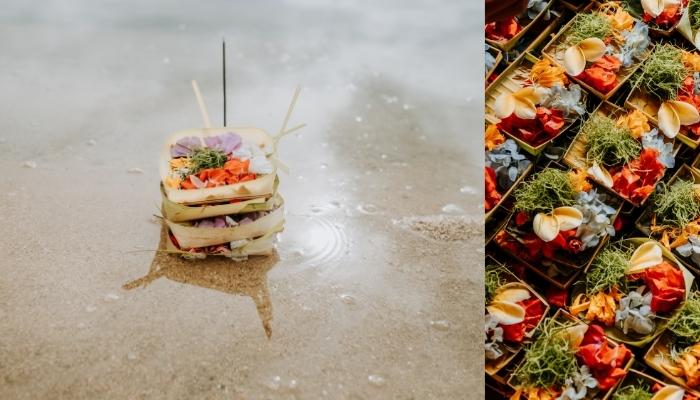What Is That Little Offering Called Canang in Bali?
If you’ve ever visited Bali, you’ve likely seen small containers filled with colorful flowers placed in front of houses, shops, or even along the streets. These are called Canang. Despite their simple appearance, canang holds deep meaning and plays an important role in the daily lives of Balinese Hindus.
In this article, we’ll dive deeper into what canang is all about — its meaning, function, various types, and the values embedded in this beautiful tradition.
What Exactly Is Canang?
Canang is a form of offering that is almost always present in the daily life of Balinese Hindus. It is usually made from young coconut leaves shaped into a small tray, then filled with flowers and other ritual items. Canang symbolizes gratitude and serves as a form of respect to God and the forces of nature.
The word canang is believed to come from two words: ca, which means “beautiful,” and nang, which means “intention.” So, canang can be interpreted as a beautiful offering made with sincere intention.
Why Is Canang Important in Bali?
In Bali, life is not just about human-to-human relationships. There’s a holistic philosophy known as Tri Hita Karana, which emphasizes three harmonious relationships:
-
Connection with God (Parhyangan)
-
Connection with fellow humans (Pawongan)
-
Connection with the environment (Palemahan)
Canang represents the effort to maintain balance between these three elements. Through canang, Balinese people express gratitude while also nurturing spiritual peace and universal harmony.
What’s Inside a Canang Offering?
Although it’s small in size, the contents of a canang carry deep symbolic meanings. A typical canang includes the following components:
-
Ceper: A base made from woven coconut leaves, serving as the foundation.
-
Peporosan: A combination of betel leaf, lime, areca nut, and tobacco — symbolizing the three divine aspects: creator, preserver, and destroyer.
-
Colorful flowers: Each color and placement direction has meaning. For example: white (east), red (south), yellow (west), and blue/green (north).
-
Sampian: A decorative topping made of palm leaf.
-
Coins or small change: Representing material sacrifice and sincere intention.
-
Incense sticks
Most types of canang include these components, but some may vary depending on their purpose or the occasion.
Types of Canang in Bali
Surprisingly, canang is not just one single type. There are many variations depending on the place and purpose. Let’s take a look at some common types:
1. Canang Sari
The most common type, found everywhere from homes to businesses. It contains basic elements: ceper, peporosan, flowers, and incense.
2. Canang Genten
A simpler version, usually just flowers without peporosan. Used for less formal daily offerings.
3. Canang Burat Wangi
A more elaborate offering, sometimes including food, snacks, porridge, or cigarettes. Used during major ceremonies or sacred days.
4. Canang Luhur
Placed in higher sacred places such as family temples. It has a more complex structure and deeper spiritual meaning.
5. Canang Ayaban
Used when seeking protection or blessings, such as before starting a business or traveling.
6. Canang Daksina
Used in purification rituals. Often more intricate and may be accompanied by other offerings like tumpeng or fruits.
7. Canang Panyembah
Specifically used for praying or personal devotion. Usually placed in front of family shrines or small altars.
Making a Canang
While it’s common now to buy ready-made canang from markets or street vendors, many people still prefer to make them at home. Hand-making canang is considered more meaningful, as it reflects sincere intent and mindfulness. The process varies depending on the type and purpose, but is usually done in the morning before starting daily activities.
Creating canang is not just a ritual — it’s a moment of reflection and a way to strengthen family bonds.
When and Where Is Canang Offered?
Canang is usually offered in the morning, though it may also be done in the afternoon depending on one’s schedule. Placement is based on function:
-
House entrance – for protection and energy balance
-
Shrines or temples – to honor and communicate with the divine
-
Kitchen – to respect the element of fire
-
Personal vehicles – for safety during travel
-
Shops or offices – to bless business and ensure smooth fortune
When placing a canang, it’s often accompanied by a silent prayer or a simple mantra.
Life Values Behind Canang
The tradition of making and offering canang teaches many life lessons:
-
Cultivating daily gratitude, even for small things
-
Sharing with nature and unseen energies
-
Maintaining balance between the physical and spiritual worlds
-
Reinforcing meaningful and positive daily habits through intention
Canang in Modern Times
Even in the face of modernization, canang remains relevant in Bali. Many public places like hotels, cafes, and malls still provide canang as a sign of cultural preservation.
There have also been innovations: canang is now sold online, there are canang-making workshops, and offerings can be customized for specific events or ceremonies.
Conclusion: Canang, A Symbol of Gratitude in Balinese Life
Canang is a meaningful part of daily life in Bali. Through it, the Balinese express gratitude, hope, and goodwill toward the universe. Though small and often overlooked by outsiders, canang carries profound philosophical values about living in harmony, with respect and simplicity.
So, if you find yourself in Bali and come across a canang, take a moment to observe and appreciate it. Because sometimes, it’s in the smallest things that we find the greatest beauty — especially when done with sincere intention. 🌼












